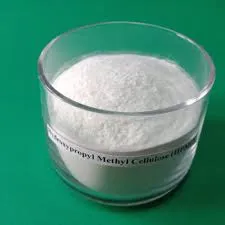
Dec . 09, 2024 22:14 Back to list
Exploring HPMC Dispersion Characteristics for Enhanced Material Performance in Various Applications
HPMC Dispersion An Overview of Its Applications and Importance
Hydroxypropyl Methylcellulose (HPMC) is a non-ionic, water-soluble polymer derived from cellulose. Its unique chemical structure imparts a variety of properties that make it an essential ingredient in many industries, particularly in construction, pharmaceuticals, and food technology. One of the most important forms of HPMC is its dispersion, which plays a crucial role in several applications due to its ability to modify viscosity, improve stability, and enhance adhesion.
Properties of HPMC Dispersion
HPMC dispersions exhibit several key properties that make them versatile they are highly soluble in cold water and form a gel-like consistency upon heating, allowing for easy manipulation in various processes. The polymer’s hydrophilic nature helps it to retain moisture, which is vital in applications such as wall paints and construction materials. Additionally, HPMC dispersions contribute to the formation of stable emulsions, thus enhancing the performance of cosmetic products and personal care formulations.
Applications in Construction
In the construction industry, HPMC dispersion is used predominantly as a thickening and water-retention agent in cement-based products, such as mortars, plasters, and adhesives. When added to these mixtures, it enhances workability, allowing for easier application and leveling. Moreover, the water-retention properties ensure that the mixtures remain workable for an extended period, which is crucial for large-scale projects. This property also helps prevent cracking and shrinkage in the final hardened product, leading to improved durability and performance.
Pharmaceutical Uses
hpmc dispersion

The pharmaceutical industry has also embraced HPMC dispersion for its binding and coating properties. It is commonly used in the production of tablets and capsules, where it acts as a binder to ensure uniformity and stability of the formulation. Furthermore, HPMC is employed in controlled-release drug formulations, as it can regulate the release rate of the active ingredients over time. This capability is essential for improving patient compliance and therapeutic efficacy.
Food Industry Applications
In the food industry, HPMC dispersion serves as an emulsifier, thickener, and stabilizer. It is often incorporated in gluten-free and low-fat products, providing the necessary texture and mouthfeel that traditional ingredients would normally offer. Additionally, HPMC helps to maintain the quality of baked goods, extending their shelf life by retaining moisture and preventing staleness. Its functional properties make it an invaluable additive in food formulations, contributing to both quality and consumer satisfaction.
Environmental Benefits
HPMC is regarded as environmentally friendly due to its biodegradable nature. As consumers and manufacturers become more conscious of environmental sustainability, HPMC's biodegradable properties position it as a preferred choice in various formulations. This aligns with global trends toward green chemistry and sustainable manufacturing practices.
Conclusion
HPMC dispersion represents a versatile and essential component across multiple industries. Its unique properties contribute to improved product performance in construction, pharmaceuticals, and food technology. As demands for sustainable and high-performance materials rise, the use of HPMC will likely continue to expand. With ongoing research and development, HPMC dispersions are expected to play an even more significant role in innovative applications, representing a vital resource for modern manufacturing and product formulation.
-
Unlocking the Benefits of HPMC Products: A Gateway to Versatile Applications
NewsAug.07,2025
-
Unleashing the Potential of HPMC Ashland: A Comprehensive Look
NewsAug.07,2025
-
Tile Bonding Cellulose: The Key to Superior Adhesion and Durability
NewsAug.07,2025
-
Hydroxypropyl Methylcellulose Powder: The Versatile Component in Modern Pharmaceuticals
NewsAug.07,2025
-
Hydroxyethyl Cellulose: The Versatile Solution for Various Industries
NewsAug.07,2025
-
Hydroxyethyl Cellulose (HEC): The Versatile Polymer for Various Applications
NewsAug.07,2025







